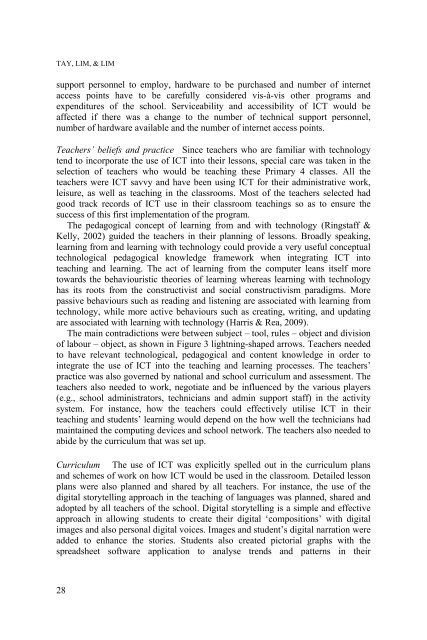1517-creating-holistic-technology-enhanced-learning-experiences
1517-creating-holistic-technology-enhanced-learning-experiences
1517-creating-holistic-technology-enhanced-learning-experiences
You also want an ePaper? Increase the reach of your titles
YUMPU automatically turns print PDFs into web optimized ePapers that Google loves.
TAY, LIM, & LIM<br />
support personnel to employ, hardware to be purchased and number of internet<br />
access points have to be carefully considered vis-à-vis other programs and<br />
expenditures of the school. Serviceability and accessibility of ICT would be<br />
affected if there was a change to the number of technical support personnel,<br />
number of hardware available and the number of internet access points.<br />
Teachers’ beliefs and practice Since teachers who are familiar with <strong>technology</strong><br />
tend to incorporate the use of ICT into their lessons, special care was taken in the<br />
selection of teachers who would be teaching these Primary 4 classes. All the<br />
teachers were ICT savvy and have been using ICT for their administrative work,<br />
leisure, as well as teaching in the classrooms. Most of the teachers selected had<br />
good track records of ICT use in their classroom teachings so as to ensure the<br />
success of this first implementation of the program.<br />
The pedagogical concept of <strong>learning</strong> from and with <strong>technology</strong> (Ringstaff &<br />
Kelly, 2002) guided the teachers in their planning of lessons. Broadly speaking,<br />
<strong>learning</strong> from and <strong>learning</strong> with <strong>technology</strong> could provide a very useful conceptual<br />
technological pedagogical knowledge framework when integrating ICT into<br />
teaching and <strong>learning</strong>. The act of <strong>learning</strong> from the computer leans itself more<br />
towards the behaviouristic theories of <strong>learning</strong> whereas <strong>learning</strong> with <strong>technology</strong><br />
has its roots from the constructivist and social constructivism paradigms. More<br />
passive behaviours such as reading and listening are associated with <strong>learning</strong> from<br />
<strong>technology</strong>, while more active behaviours such as <strong>creating</strong>, writing, and updating<br />
are associated with <strong>learning</strong> with <strong>technology</strong> (Harris & Rea, 2009).<br />
The main contradictions were between subject – tool, rules – object and division<br />
of labour – object, as shown in Figure 3 lightning-shaped arrows. Teachers needed<br />
to have relevant technological, pedagogical and content knowledge in order to<br />
integrate the use of ICT into the teaching and <strong>learning</strong> processes. The teachers’<br />
practice was also governed by national and school curriculum and assessment. The<br />
teachers also needed to work, negotiate and be influenced by the various players<br />
(e.g., school administrators, technicians and admin support staff) in the activity<br />
system. For instance, how the teachers could effectively utilise ICT in their<br />
teaching and students’ <strong>learning</strong> would depend on the how well the technicians had<br />
maintained the computing devices and school network. The teachers also needed to<br />
abide by the curriculum that was set up.<br />
Curriculum The use of ICT was explicitly spelled out in the curriculum plans<br />
and schemes of work on how ICT would be used in the classroom. Detailed lesson<br />
plans were also planned and shared by all teachers. For instance, the use of the<br />
digital storytelling approach in the teaching of languages was planned, shared and<br />
adopted by all teachers of the school. Digital storytelling is a simple and effective<br />
approach in allowing students to create their digital ‘compositions’ with digital<br />
images and also personal digital voices. Images and student’s digital narration were<br />
added to enhance the stories. Students also created pictorial graphs with the<br />
spreadsheet software application to analyse trends and patterns in their<br />
28


